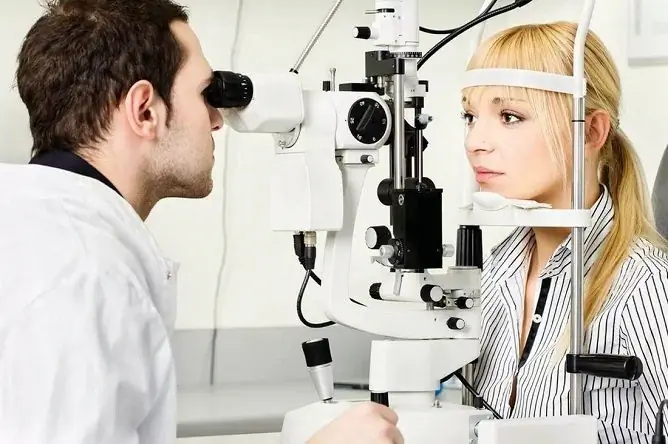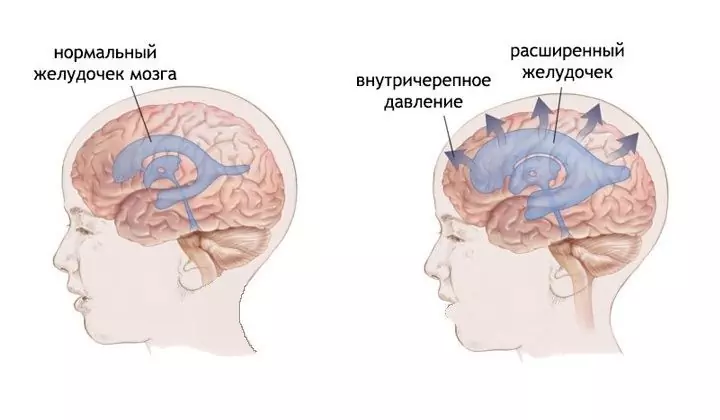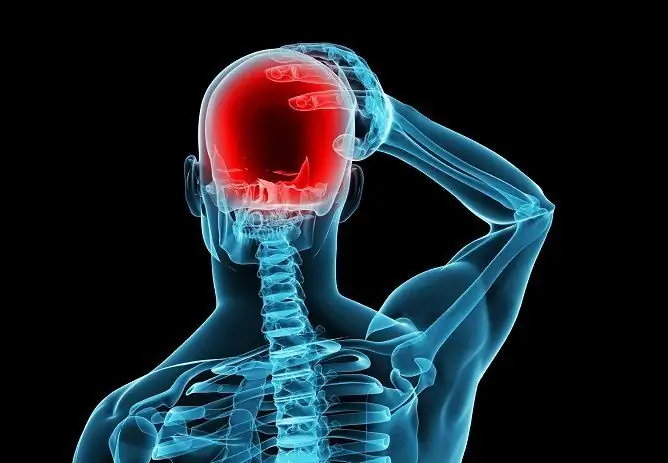- Author Rachel Wainwright [email protected].
- Public 2023-12-15 07:39.
- Last modified 2025-11-02 20:14.
How to check intracranial pressure, determine intracranial hypertension in adults and children
The content of the article:
- Symptoms of increased cranial pressure
- How to check intracranial pressure in an adult
- How to measure intracranial pressure in a child
- Causes of intracranial hypertension
- Treatment Approach
- Video
How to determine intracranial pressure when it rises is a natural question that arises in people suffering from symptoms of pathology, the main one of which is a painful headache.
Increased intracranial pressure (ICP), which is also called intracranial hypertension, is a dangerous condition, since prolonged compression of the brain causes deterioration of its functions, structural disorders, and in the most severe cases, it can cause death.

It is most convenient to diagnose increased ICP by ophthalmoscopy
If intracranial hypertension is suspected, it is necessary to consult a doctor and undergo an examination, since it is not possible to check intracranial pressure at home. What symptoms can indicate this pathology?
Symptoms of increased cranial pressure
For increased intracranial pressure, a triad of signs is characteristic:
- Headache. The pain in this case intensifies at night, closer to morning, is not relieved or is poorly relieved by analgesics, increases with a change in body position, especially when the head is lowered, and has a pressing, bursting character.
- Nausea, vomiting. These symptoms are not associated with food intake, appear and intensify as the headache intensifies; after vomiting, which can be repeated, the headache usually decreases.
- Visual impairment. This can be a decrease in visual acuity, the appearance of spots and flashes in front of the eyes, loss of lateral visual fields. This symptom is associated with swelling of the optic nerve head due to compression.
In addition, dizziness, lethargy, heart rhythm disturbances, excessive sweating, and decreased cognitive functions often appear.
In children, it is much more difficult to recognize increased intracranial pressure by external manifestations. Symptoms that may indicate pathology in newborns and infants include:
- anxiety and loud cry of the child for no apparent reason;
- bulging fontanelle;
- disproportionate head enlargement that does not correspond to the age norm;
- the appearance of a venous network on the scalp;
- strabismus;
- sleep disorders;
- frequent regurgitation and / or profuse vomiting (vomiting is not associated with food intake);
- convulsions.
Children over 2 years of age may have a lag in mental and physical development.
However, it should be borne in mind that clinical signs are not a completely reliable basis for making a diagnosis; instrumental studies are needed to confirm intracranial hypertension and determine therapeutic tactics.
How to check intracranial pressure in an adult
The first thing that is required if intracranial hypertension is suspected is an ophthalmological examination, which reveals the so-called congestive fundus: swelling of the optic discs, dilated blood vessels, etc. This is a simple, cheap and highly informative method, which is sufficient for to diagnose increased ICP.
However, intracranial hypertension is often not an independent disease, but only a sign of another, primary pathology. In order to identify it or completely exclude it, clarifying diagnostics, including the measurement of intracranial pressure, may be required.
Methods for measuring intracranial pressure are classified as invasive or non-invasive. Invasive methods are used only when it comes to severe pathology, for example, a penetrating brain injury, tumor, etc. Their advantage is the ability to quickly reduce excess pressure by removing part of the cerebrospinal fluid (or blood, if we are talking about hematoma) … Invasive methods include:
- epidural - the measuring device is placed in a hole drilled in the skull, between the cranium and the dura mater, is brought to the lateral part of the cerebral ventricle, where measurements are taken;
- subdural - a subdural screw is inserted into the trepanation hole in the skull, with the help of which measurements are taken;
- intraventricular - a catheter is inserted into the skull through a burr hole and measures the level of intracranial pressure.
In addition to ophthalmoscopy, non-invasive diagnostics of intracranial pressure include:
- echoencephalography - a method of ultrasound diagnostics that allows you to assess the state of cerebral structures, brain pulsation and a number of other indicators;
- transcranial doppler of the brain - an ultrasound examination of the blood vessels of the brain using the Doppler effect, which measures the speed of blood movement in the middle of the basal vein and venous sinus;
- otoacoustic method - the conclusion about the level of intracranial pressure is made based on the degree of displacement of the tympanic membrane.
In addition, you can find out the level of intracranial pressure based on the results of magnetic resonance imaging or computed tomography, which allow visualizing the filling of blood vessels, the state of the CSF circulation pathways, the presence of neoplasms, and displacement of the brain structures.
How to measure intracranial pressure in a child
In children, ICP is measured using the same methods as in adults, but in infants with open fontanelles there is another test that is largely preferred. We are talking about neurosonography - an ultrasound examination of the brain, which is informative, moreover safe and painless.

Until the child's fontanelles are closed, neurosonography is used to measure ICP
Causes of intracranial hypertension
High cranial pressure occurs in patients of all ages and requires immediate treatment, as it can cause irreversible functional and sometimes structural disorders of the brain.
An increase in intracranial pressure is observed with excessive production of cerebrospinal fluid, as well as a violation of its outflow. The latter is more common and can occur against the background of hydrocephalus, meningitis, encephalitis, otitis media, malaria, craniocerebral trauma, injury to the blood vessels of the neck, hypertension, cerebral hemorrhages, tumors and cysts of the brain.
Sometimes the cause cannot be found, in which case idiopathic intracranial hypertension is diagnosed. Overweight, frequent stressful situations, poor nutrition, the presence of bad habits, a passive lifestyle contribute to the development of pathology.
Treatment Approach
The treatment regimen for intracranial hypertension depends on its cause, the severity of clinical signs and is glad of individual indications. Based on these parameters, treatment can be conservative, surgical and combined.
Drug therapy consists of the use of diuretics, sedatives, antispasmodics, pain relievers.
Surgical treatment involves the removal of neoplasms (tumors, cysts, hematomas) and / or bypass surgery, i.e. creating an artificial outflow for the cerebrospinal fluid.
In addition to the main treatment, physiotherapy, massage, folk remedies (after consulting a doctor) can be used.
In idiopathic intracranial hypertension, lifestyle correction is required: proper nutrition, normalization of work and rest, regular but moderate physical activity, daily stay in the fresh air.
Video
We offer for viewing a video on the topic of the article.

Anna Aksenova Medical journalist About the author
Education: 2004-2007 "First Kiev Medical College" specialty "Laboratory Diagnostics".
Found a mistake in the text? Select it and press Ctrl + Enter.






